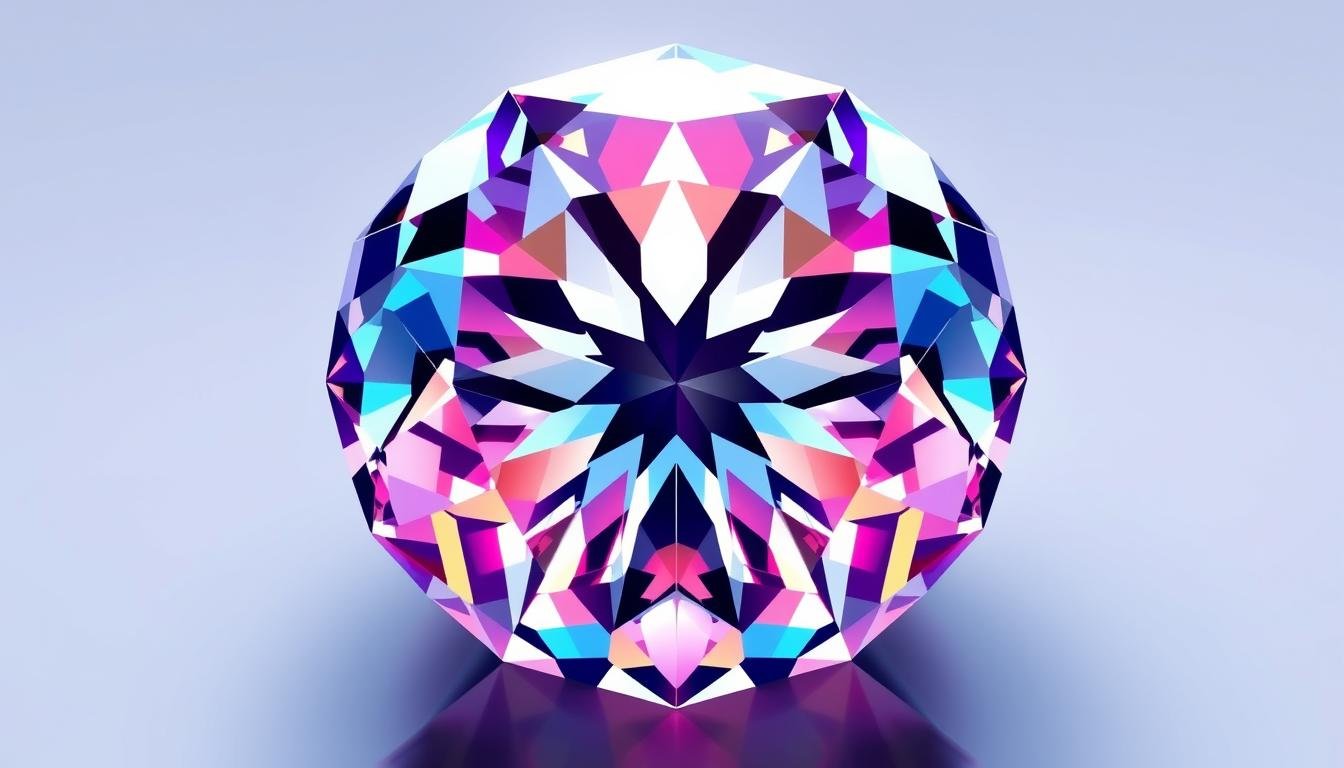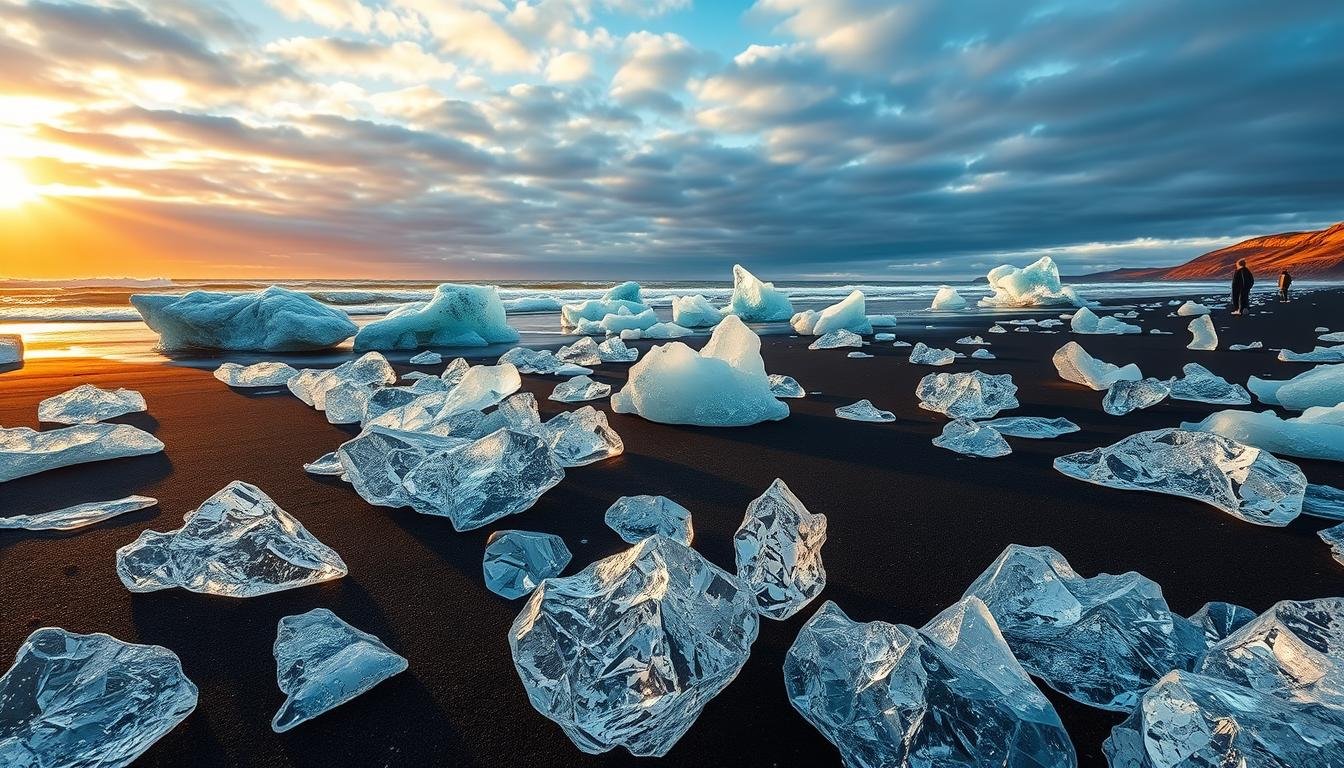Start a fascinating journey into diamond illustration. Here, the beauty of precious stones comes to life through art. You’ll learn the basics of making stunning gemstone art designs. This will unlock the secrets of diamond illustration and its role in jewelry and fine art.
Diamonds have always amazed artists, designers, and fans with their sparkle and timeless charm. Learning diamond illustration opens a world of creativity. It lets you capture the essence of these mesmerizing gems and turn them into stunning art.
Key Takeaways
- Discover the fundamental principles of diamond illustration and gemstone art design
- Learn how to utilize light and reflection to create realistic and visually striking gem drawings
- Explore the history and evolution of precious stone artwork, from traditional techniques to cutting-edge digital methods
- Understand the essential tools and materials required for diamond sketching and illustration
- Develop a keen eye for color theory and its application in jewelry design and gemstone rendering
Understanding the Fundamentals of Diamond Illustration
Making beautiful diamond sketches and jewelry designs needs a solid grasp of diamond basics. You must know about their intricate facets and how light reflects off them. This knowledge is key for any gemological rendering artist.
Basic Geometry and Structure
Diamonds are known for their stunning symmetry and precise shapes. It’s important to learn about different cuts like round brilliant and emerald. Knowing the parts of a diamond helps you create designs that truly show off these gems.
Light and Reflection Principles
The sparkle of a diamond comes from how light interacts with it. Learning about refraction, dispersion, and total internal reflection is crucial. This knowledge helps you make diamond illustrations that look real and stunning.
Essential Tools and Materials
Whether you draw by hand or use digital tools, the right equipment is vital. You’ll need top-notch pencils, paper, and maybe even a graphic tablet or design software. Having the right tools lets you bring your ideas to life.
“The true beauty of a diamond lies not only in its physical appearance but in the mastery of its intricate details and the captivating play of light that brings it to life.”
Exploring diamond illustration basics will help you create amazing jewelry designs. Dive into the world of diamond geometry and light. Let your creativity shine through in your work.
The History and Evolution of Gemstone Art
Gemstone art has a long and fascinating history. It started in ancient times when people used precious minerals to create beautiful art. Gemstone art and precious mineral illustration have changed a lot over time. They show how human creativity and technology have grown.
In ancient Egypt, gemstone art was first seen in the jewelry and ornaments found in pharaohs’ tombs. These pieces were full of colorful gemstones. They showed the skill and detail of early gemstone art.
As time went on, the ways and materials used in gemstone art changed. During the Renaissance, more people wanted to use gemstones in their art. This led to amazing works, from religious items to fancy court accessories. The skills in cutting and setting gemstones improved a lot during this time.
In the 19th and 20th centuries, precious mineral illustration changed a lot. Photography and easier access to different gemstones helped artists. They could show the beauty and details of gemstones in a new way.
| Era | Gemstone Art Developments |
|---|---|
| Ancient Egypt | Intricate jewelry and ornaments with vibrant gemstones |
| Renaissance Period | Surge in gemstone-encrusted artworks, advancements in cutting and setting techniques |
| 19th and 20th Centuries | Photographic techniques and accessibility of diverse gemstone sources enable realistic mineral illustrations |
Today, gemstone illustration keeps getting better. Artists use old ways and new technology together. They have many tools now, which lets them make amazing precious mineral art. This history and ongoing growth make gemstone art very interesting to artists, collectors, and fans.
Essential Tools and Techniques for Diamond Drawing
In the world of diamond painting and gem artistry, choosing between digital and traditional methods is key. Each has its own benefits, fitting different artists and hobbyists. This choice greatly affects the creative journey.
Digital vs. Traditional Methods
Digital methods have changed diamond painting, making it easier and more flexible. Artists use software and hardware to get detailed designs and colors. On the other hand, traditional methods like pencil sketching and watercolor painting offer a hands-on experience.
Software and Hardware Requirements
For digital diamond painting, knowing the right tools is essential. This includes top illustration software and graphics tablets. The right equipment can greatly enhance your gem artistry.
Color Theory for Gem Rendering
Understanding color theory is crucial for capturing the beauty of gems. Whether digital or traditional, knowing about color, light, and shadow is key. This knowledge helps bring out the true beauty of gems in your work.
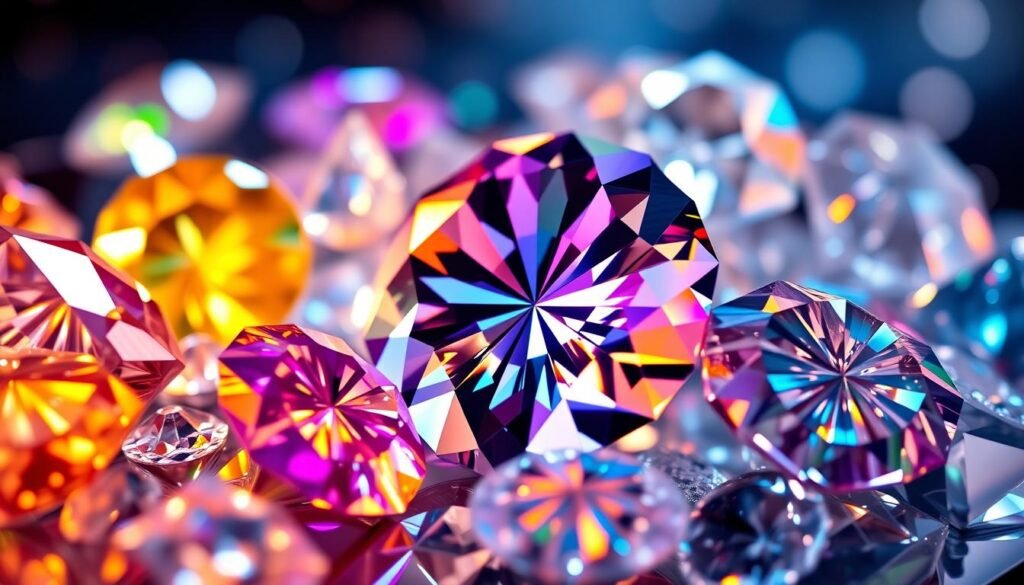
“The true beauty of a diamond lies not only in its physical magnificence but also in the artistic expression it inspires.”
Mastering Light and Shadow in Precious Stone Drawing
Making stunning gem illustrations needs a deep grasp of light and stone interaction. From diamonds’ bright sparkle to colored gems’ deep allure, getting light and shadow right is key. It brings your artwork to life.
Diamond etching is a vital technique in this art. Artists use it to show a gem’s detailed facets and inner glow. By understanding diamonds’ unique shape and how they reflect light, artists can show the stone’s amazing optical effects.
“The true essence of a gem lies in its ability to capture and reflect light. As an artist, it’s my mission to translate that mesmerizing interplay onto the canvas.”
Having a sharp eye for light and shadow also lets artists add depth and dimension to their precious stone drawings. They use layering, subtle highlights, and shadows to make the gem seem to pop off the page. This grabs the viewer’s attention.
Unlocking the Secrets of Gemstone Luminance
To excel in precious stone drawing, artists must grasp the basics of light and gem interaction. This includes:
- Studying each gem’s unique refractive properties
- Understanding how different lights affect the stone’s look
- Trying out methods to show highlights and shadows
By carefully applying these methods, artists can reveal the secrets of gemstone light. They create stunning, lifelike pieces that engage the viewer’s senses.
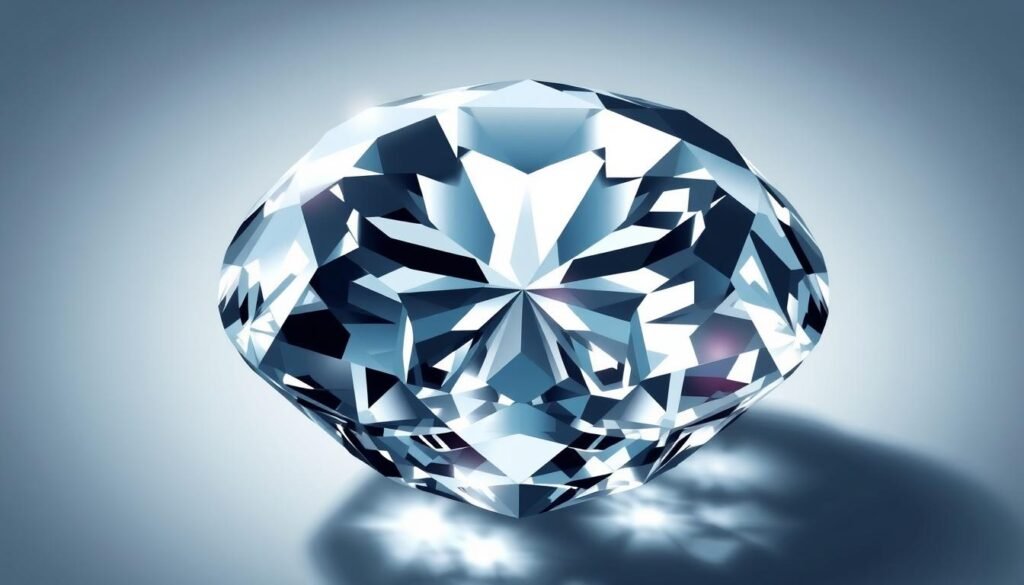
| Technique | Description | Examples |
|---|---|---|
| Diamond Etching | Leveraging precise highlight and shadow placement to capture a diamond’s intricate facets and inner brilliance | Gem illustrations showcasing diamond etching |
| Layering Gradients | Using gradients to add depth and dimensionality to precious stone drawings | Illustrations demonstrating the use of gradients in gem art |
| Highlight and Shadow Placement | Strategically placing highlights and shadows to enhance the gem’s visual appeal and luminance | Examples of precious stone drawings with masterful light and shadow techniques |
Step-by-Step Guide to Diamond Illustration
Learning diamond illustration is a fun journey. It lets you show the beauty and sparkle of diamonds. We’ll guide you through making a beautiful gemstone art piece step by step.
Initial Sketching Phase
Start by drawing the diamond’s basic shape. Focus on its geometric parts for a strong base. Try different views to find the most interesting angle of the gem.
Adding Depth and Dimension
To make your illustration look real, add light and shadow. Watch how light hits the diamond’s facets, creating patterns and reflections. Use shading to build depth and make your drawing pop.
Finalizing Details and Highlights
In the last step, focus on the details and sparkles. Add the intricate patterns and shine that diamonds are known for. Make sure to capture the gem’s surface details for a realistic and stunning finish.
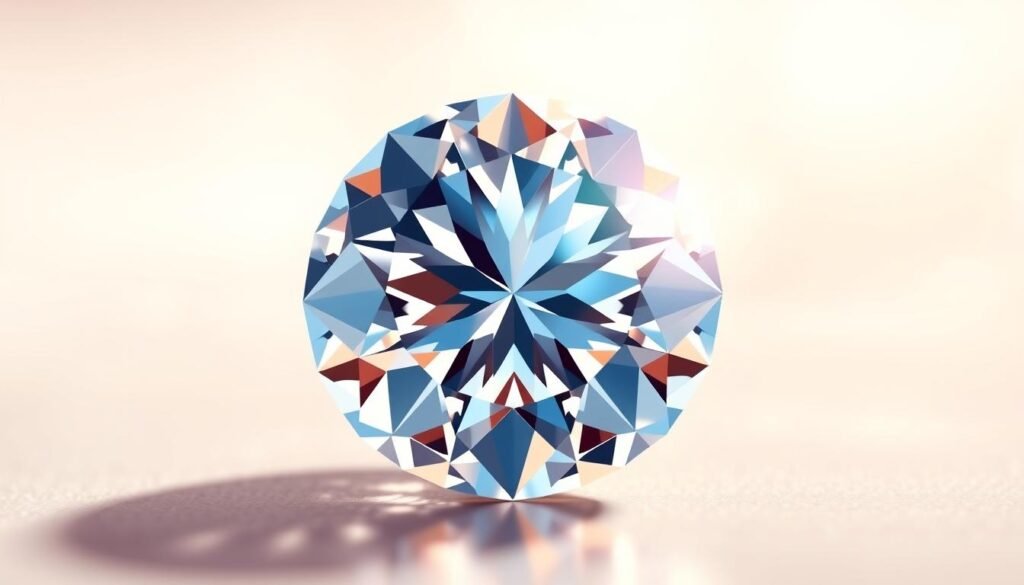
By following these steps, you’ll create amazing diamond illustrations. Let your creativity flow, try new things, and show off your artistic side.
Advanced Techniques in Gemological Rendering
Aspiring gem artists need to learn advanced techniques to improve their precious mineral illustration. These methods make their work more detailed and visually stunning. They draw in viewers with their intricate details and amazing visual effects.
Understanding facet structures is key. Artists learn how light and reflection work in gem cuts. This lets them show the brilliance of diamonds, rubies, and other gems. It’s especially important for diamond illustrations, making them truly enchanting.
Learning about advanced lighting effects is also crucial. Artists use light and shadow to add depth and drama to their work. This makes the gemstones seem more alive and engaging.
There are also special ways to draw different precious minerals. Each one, like amethyst or opal, needs its own technique. This knowledge helps artists create pieces that truly show off the beauty of these gems.
“The true artist is not the one who creates the most intricate or realistic illustration, but the one who can breathe life into the gem, inviting the viewer to experience its captivating essence.”
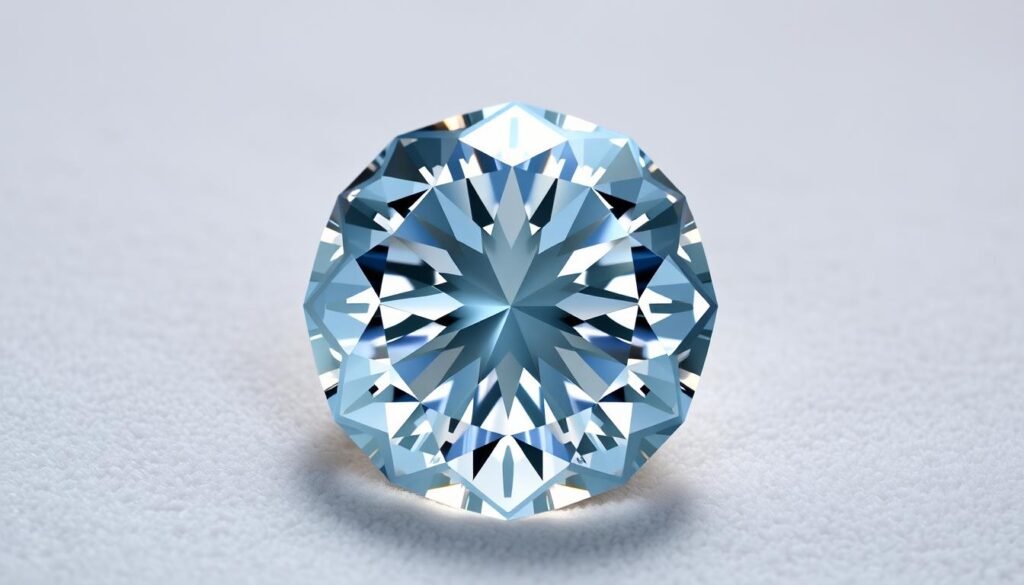
By mastering these advanced techniques, gem artists can take their work to new heights. They can show off the beauty of diamonds and rare gems in amazing ways. These skills help artists bring the world of gemology to life in incredible ways.
Color Theory and Application in Jewelry Design
In the world of jewelry design, knowing color theory is key. Jewelry designers need to understand colors and use them well to make beautiful gem artistry. This part talks about the basics of color theory and how to use it in jewelry making.
Understanding Color Schemes
Color schemes are important in jewelry design. They can set the mood and feelings of a piece. Designers should know about different color schemes like complementary, analogous, and triadic. This ensures their designs look good and grab attention.
Creating Realistic Gem Colors
Making gem colors look real is a big part of jewelry design. Designers need to know about gemstones’ special qualities. This includes their shine, how light spreads, and any inclusions. This knowledge helps them get the colors and looks right.
Digital Color Enhancement
Today, designers use software to make their jewelry designs pop. They can change colors, play with light, and more. These digital tools help designers perfect their gem artistry and bring their ideas to life.
| Color Scheme | Description | Jewelry Design Applications |
|---|---|---|
| Complementary | Colors that are opposite each other on the color wheel, such as blue and orange, create a high-contrast and vibrant look. | Complementary colors can be used to create striking and attention-grabbing jewelry designs, particularly for statement pieces. |
| Analogous | Colors that are adjacent on the color wheel, such as blue, green, and teal, create a harmonious and cohesive palette. | Analogous color schemes work well for creating subtle, sophisticated jewelry designs that blend seamlessly together. |
| Triadic | Colors that are evenly spaced on the color wheel, such as red, yellow, and blue, create a vibrant and energetic look. | Triadic color schemes can be used to design bold, eye-catching jewelry pieces that stand out and make a statement. |
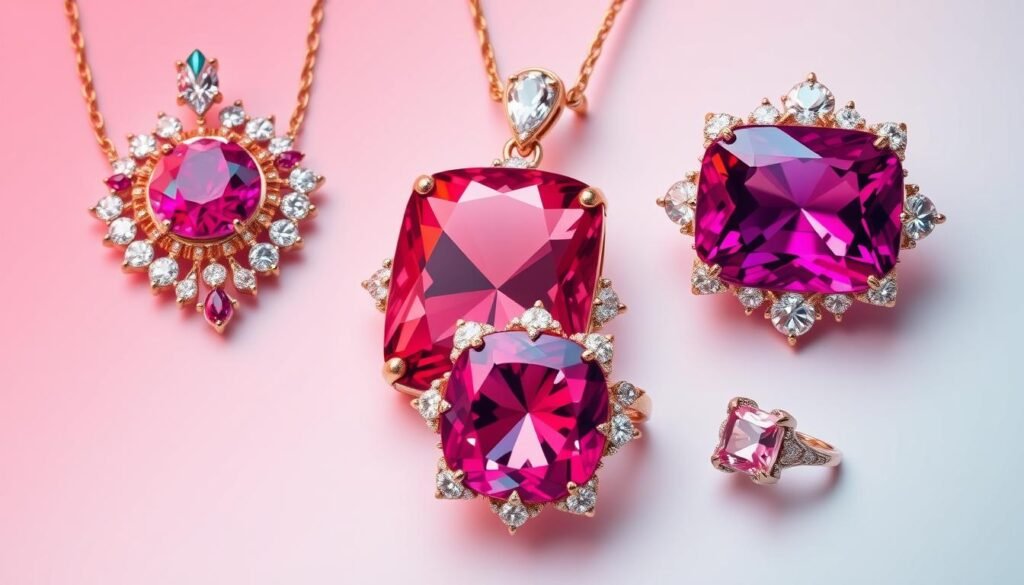
“Understanding color theory is not just an artistic pursuit; it’s a critical skill for jewelry designers who want to create pieces that captivate and inspire.”
Common Mistakes to Avoid in Diamond Sketching
Diamond sketching and painting is a captivating art form. Even experienced artists can make common mistakes. Knowing these pitfalls helps you create more accurate and striking diamond illustrations.
One big mistake is ignoring the intricate geometry and symmetry of diamonds. Not accurately showing facets, angles, and proportions can make your work look flat. It’s crucial to understand gemstone geometry to create authentic diamond sketches.
Another mistake is not handling light and reflection properly. Diamonds sparkle, but capturing this requires knowing how light interacts with them. Missing the details of light refraction and highlights can make your paintings dull.
- Neglecting the intricate geometry and symmetry of diamond structures
- Improper handling of light and reflection
- Oversaturating or underutilizing color palettes
- Lack of attention to depth and dimension
- Failing to incorporate realistic textures and surfaces
Many artists also struggle with color theory in diamond illustrations. Using too many colors or not using realistic gem tones can lower your work’s quality. It’s important to master color theory and use it wisely for stunning diamond paintings.
Lastly, not focusing on depth and dimension can make your sketches look flat. Using techniques like strategic shading and highlighting can make your diamond come alive. This adds depth and makes your work more captivating.
By avoiding these common mistakes and focusing on the basics of diamond illustration, artists can reach their full potential. They can create breathtaking diamond sketches and paintings that grab the viewer’s attention.
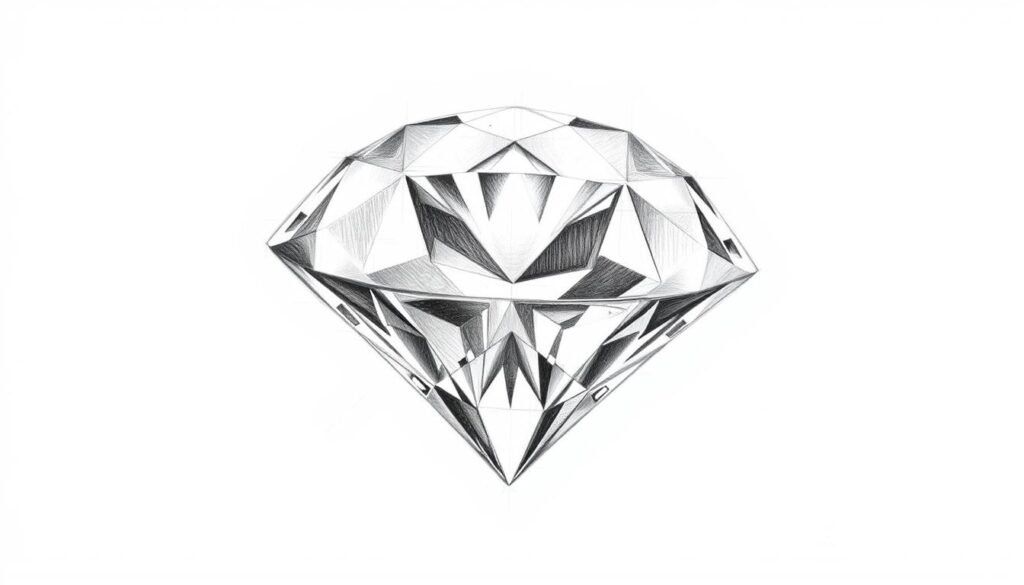
Digital Tools and Software for Gem Artistry
Digital tools and software have changed the game in gem artistry and diamond illustration. They help in designing jewelry and showing off gemstones’ sparkle. These tools are key for modern gem artistry and diamond illustration.
Popular Software Choices
There are many digital tools for gem artists and diamond illustrators. Programs like Adobe Illustrator, Photoshop, and Corel DrawX are popular. They offer features for creating detailed gem illustrations and designs.
These apps let artists be creative. They can make detailed vector illustrations or digital paintings.
Digital Brushes and Effects
Digital gem artistry shines with special brushes and effects. Designers use customizable brushes and light effects to make their designs pop. This lets them show off the sparkle and details of gemstones with great precision.
File Formats and Export Options
Choosing the right file format is important at the end. Designers can pick from JPEG, PNG, SVG, or 3D models. This makes it easy to share their work on different platforms and in various ways.
| Software | Key Features | Suitability |
|---|---|---|
| Adobe Illustrator | Vector-based illustrations, precise control over shapes and lines | Detailed, technical diamond drawings and jewelry designs |
| Adobe Photoshop | Raster-based editing, advanced lighting and texture effects | Realistic gem renderings, digital painting, and photo-manipulation |
| Corel DrawX | Versatile vector and raster tools, specialized gem design templates | All-purpose gem artistry and diamond illustration workflows |
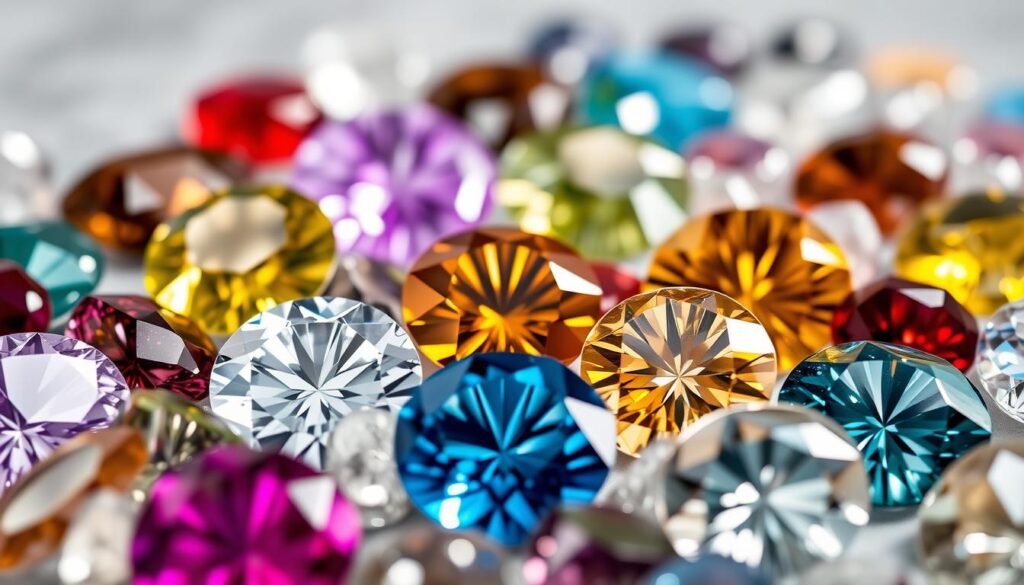
The digital world has changed gem artistry and diamond illustration a lot. It gives designers many tools to improve their work. With these tools, gem lovers can be more creative and share their stunning gem artistry with the world.
Conclusion
As we wrap up our exploration of diamond illustration, gemstone art, and jewelry design, we hope you’ve learned a lot. Mastering these techniques is key for anyone wanting to create beautiful, realistic gemstone pictures.
This guide has given you the tools and knowledge to improve your jewelry design skills. It’s all about light, shadow, and color, and how to draw them well. Remember, getting better at drawing diamonds is a lifelong journey. It’s full of chances to try new things, learn, and grow as an artist.
Keep working on your gemstone art skills. We encourage you to face challenges, celebrate your wins, and always aim to make designs that show off the beauty of these precious stones. The world is your canvas, and there’s no limit to what you can create. Happy creating!

Hi, I’m Jimmy, the founder of Brilliant Jewelry Guide. With years of experience and a passion for timeless jewelry, I’m here to help you find pieces that tell your story and celebrate life’s special moments.
Disclaimer: This article contains affiliate links, which means we may earn a small commission if you purchase through them, without any additional cost to you. The content on this website was developed with assistance from AI.
